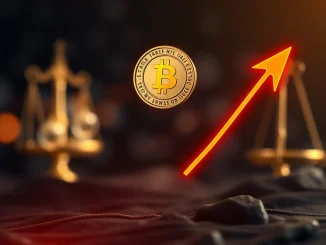
In the fast-paced world of cryptocurrency, where volatility is a constant companion, understanding broader macroeconomic forces isn’t just an advantage—it’s a necessity. While Bitcoin and altcoins often chart their own courses, they remain inextricably linked to global liquidity, investor sentiment, and the overall health of traditional financial markets. This week brings a series of pivotal economic events that could send ripples across all asset classes, including your crypto portfolio. Are you ready to navigate the potential shifts?
Understanding the Crucial Impact of Economic Events on Crypto
Why should a crypto enthusiast care about a central bank meeting or an interest rate decision thousands of miles away? The answer lies in the interconnectedness of global finance. Major economic announcements influence everything from bond yields and currency valuations to corporate earnings and consumer spending. These factors collectively shape the ‘risk-on’ or ‘risk-off’ sentiment that often dictates capital flows into speculative assets like cryptocurrencies.
When central banks tighten monetary policy (e.g., raise interest rates), borrowing becomes more expensive, economic growth can slow, and investors tend to move away from riskier assets towards safer havens. Conversely, looser monetary policy (e.g., rate cuts, quantitative easing) can inject liquidity into the system, encouraging investment in growth-oriented and higher-risk assets, including digital currencies.
This week’s calendar is packed with such potential catalysts. Let’s break down the key moments and what they might mean for your crypto holdings:

| Date | Time (UTC) | Country | Event | Significance |
|---|---|---|---|---|
| Monday, July 21 | 01:00 | China | Loan Prime Rate 5Y (July) | Key benchmark for corporate and household lending; impacts economic stimulus/contraction. |
| Tuesday, July 22 | 12:30 | U.S. | Fed Chair Powell Speaks | Insights into future monetary policy, inflation outlook, and economic assessment. |
| Tuesday, July 22 | 17:00 | EU | ECB President Lagarde Speaks | Clues on Eurozone monetary policy, inflation fight, and growth prospects. |
| Thursday, July 24 | 12:15 | EU | ECB Interest Rate Decision (July) | Direct impact on Eurozone borrowing costs, liquidity, and investor sentiment. |
Key Central Bank Decisions on the Horizon: Powell and Lagarde in Focus
Central bankers hold immense sway over global financial markets. Their words and actions can trigger significant shifts in investor behavior. This week, eyes will be glued to the United States Federal Reserve Chair Jerome Powell and European Central Bank (ECB) President Christine Lagarde.
Fed Chair Powell Speaks (Tuesday, July 22, 12:30 UTC)
When Fed Chair Powell speaks, the world listens. His remarks often provide crucial insights into the Federal Reserve’s current assessment of the U.S. economy, inflation trends, and, most importantly, the future path of monetary policy. Investors will be scrutinizing every word for:
- Inflation Outlook: Is the Fed confident inflation is trending towards its 2% target, or are there persistent concerns?
- Labor Market Strength: Any signs of weakening in the job market could signal a shift in policy.
- Interest Rate Trajectory: While not a formal policy meeting, Powell might offer hints about the likelihood of future rate hikes, pauses, or even cuts.
- Quantitative Tightening (QT): Updates on the Fed’s balance sheet reduction plan, which drains liquidity from the financial system.
The Crypto Connection: A hawkish tone from Powell (suggesting higher rates for longer) typically strengthens the U.S. dollar and increases the appeal of traditional safe assets, potentially putting downward pressure on Bitcoin and other cryptocurrencies. Conversely, a more dovish stance (suggesting an end to hikes or even future cuts) could weaken the dollar and foster a ‘risk-on’ environment, benefiting crypto.
ECB President Lagarde Speaks & ECB Interest Rate Decision (Tuesday, July 22, 17:00 UTC & Thursday, July 24, 12:15 UTC)
The Eurozone, a massive economic bloc, also has its moments in the spotlight. ECB President Christine Lagarde’s speech will precede the official interest rate decision, offering an early glimpse into the central bank’s thinking.
- Lagarde’s Speech: Similar to Powell, Lagarde will likely address inflation within the Eurozone, economic growth prospects, and any emerging challenges like fragmentation risks among member states.
- ECB Interest Rate Decision: This is the big one for the Eurozone. The ECB will announce whether it’s raising, cutting, or holding its key interest rates. This directly impacts the cost of borrowing for businesses and consumers across the Eurozone.
- Post-Decision Press Conference: The accompanying statement and Lagarde’s press conference will provide detailed explanations for the decision and forward guidance on future policy.
The Crypto Connection: The ECB’s policy has a direct bearing on the strength of the Euro against the U.S. dollar. A more aggressive ECB (hiking rates) could strengthen the Euro, while a more cautious approach might weaken it. These currency movements can indirectly influence global capital flows and the perceived value of assets denominated in different currencies. Furthermore, the overall health and liquidity of the Eurozone economy, driven by ECB policy, contribute to global risk appetite, impacting crypto.
China’s Loan Prime Rate: What Does it Mean for Global Market Impact?
Often overlooked by Western investors, China’s economic data and policy decisions carry significant weight due to its sheer size and role in global supply chains. The Loan Prime Rate (LPR) is China’s benchmark lending rate, set by the People’s Bank of China (PBOC).
Loan Prime Rate 5Y (Monday, July 21, 01:00 UTC)
The 5-year LPR is particularly important as it influences the pricing of mortgages and longer-term corporate loans. A cut in the LPR signals the PBOC’s intent to stimulate the economy by making borrowing cheaper, encouraging investment and consumption. A hold or, less likely, a hike, would suggest a more cautious or tightening stance.
- Stimulus vs. Caution: A cut indicates the PBOC is concerned about economic growth and is willing to provide support.
- Property Market Health: The LPR is crucial for China’s vast property sector, which has faced significant challenges.
- Global Spillover: China’s economic performance has a ripple effect. A strong Chinese economy can boost global demand and commodity prices, fostering a more positive global economic outlook. Conversely, weakness can dampen sentiment.
The Crypto Connection: While not as direct as Fed or ECB decisions, China’s economic health impacts global risk appetite. A significant stimulus from China could signal a global push for growth, potentially benefiting risk assets. Conversely, signs of continued weakness could contribute to a broader risk-off environment, affecting crypto valuations.
Navigating Volatility: Actionable Insights from Fed Powell Speech and ECB
Given the lineup of significant economic events this week, volatility in both traditional and crypto markets is a strong possibility. Here’s how you can prepare and potentially capitalize on the movements:
1. Stay Informed and Monitor Key Indicators
Keep a close eye on live news feeds and reputable financial media outlets. Pay attention not just to the initial announcements but also to the market’s immediate reaction and the commentary that follows. Look for:
- U.S. Dollar Index (DXY): A strong DXY often correlates with weaker crypto prices, and vice versa.
- Bond Yields: Rising yields (especially on U.S. Treasuries) can signal tighter financial conditions.
- Stock Market Performance: Major equity indices (S&P 500, Nasdaq) can offer clues about broader risk sentiment.
2. Review Your Portfolio and Risk Tolerance
Before these events unfold, assess your current crypto holdings. Are you over-exposed to highly volatile assets? Consider your personal risk tolerance. This is a good time to:
- Diversify: Ensure your portfolio isn’t overly concentrated in a few assets.
- Set Stop-Losses: If you’re trading, consider using stop-loss orders to limit potential downside.
- Manage Leverage: If you’re using leverage, be extra cautious. Volatility can lead to rapid liquidations.
3. Avoid Impulsive Decisions
The immediate aftermath of major economic announcements can be chaotic, with sharp price swings based on initial interpretations. It’s often wise to:
- Wait for Clarity: Allow the market to digest the information and establish a clearer trend before making significant moves.
- Focus on the Long-Term: For long-term investors, short-term volatility might be less concerning than the overall direction of monetary policy.
4. Understand the Narrative Shifts
Beyond the raw data, it’s the market’s interpretation and the resulting narrative that truly drives prices. Is the market now expecting more rate hikes? Or are concerns about a recession growing? These narrative shifts, often influenced by the Fed Powell speech and ECB commentary, will dictate broader trends.
A Week of Economic Crossroads
This week’s calendar presents a compelling series of economic events that will undoubtedly shape the narrative for global financial markets. From China’s efforts to stimulate its economy to the crucial central bank decisions by the Fed and ECB on interest rates and monetary policy, every announcement carries the potential for significant market impact. For cryptocurrency investors, staying informed about these macro developments is not just about understanding potential price movements; it’s about gaining a deeper appreciation for the forces that truly move the needle in the broader financial ecosystem. By paying attention to these pivotal moments, you empower yourself to make more informed decisions, navigate volatility with greater confidence, and potentially identify opportunities in the ever-evolving crypto landscape. Prepare wisely, stay vigilant, and remember that knowledge is your most valuable asset.
Frequently Asked Questions (FAQs)
Q1: Why do global economic events affect cryptocurrency prices?
A1: Global economic events influence overall market sentiment and liquidity. When central banks tighten monetary policy (e.g., raise interest rates), it often leads to a ‘risk-off’ environment where investors move away from speculative assets like crypto towards safer investments. Conversely, looser policies or positive economic news can foster a ‘risk-on’ environment, benefiting crypto. Additionally, the strength of major fiat currencies like the USD or EUR, influenced by these events, can impact crypto’s relative value.
Q2: What is China’s Loan Prime Rate, and why is it important?
A2: The Loan Prime Rate (LPR) is China’s benchmark lending rate, influencing interest rates on loans for businesses and mortgages. It’s important because it reflects the People’s Bank of China’s (PBOC) monetary policy stance. A cut in the LPR signals an effort to stimulate the economy by making borrowing cheaper, which can impact global demand, supply chains, and overall risk sentiment, indirectly affecting crypto markets.
Q3: How do speeches from Fed Chair Powell or ECB President Lagarde impact markets?
A3: Speeches from central bank heads like Jerome Powell (Fed) or Christine Lagarde (ECB) are closely watched for clues on future monetary policy, inflation outlook, and economic assessments. Their rhetoric can signal whether interest rates are likely to rise, fall, or remain stable, and can influence quantitative easing/tightening plans. These signals cause immediate market reactions, affecting currency strength, bond yields, and investor appetite for risk assets like crypto.
Q4: What should crypto investors do during a week with many key economic events?
A4: Crypto investors should prioritize staying informed about the events and their potential implications. It’s advisable to review your portfolio’s risk exposure, consider setting stop-loss orders if trading, and avoid making impulsive decisions based on short-term volatility. Focusing on the long-term trends and understanding the broader economic narrative can help navigate the week’s market movements more effectively.
Q5: Is there a direct correlation between central bank decisions and Bitcoin’s price?
A5: While not always a direct, one-to-one correlation, there’s a strong indirect relationship. Central bank decisions on interest rates and liquidity significantly influence the macroeconomic environment. For example, a hawkish Fed (raising rates) generally leads to a stronger U.S. dollar and tighter financial conditions, which historically tends to put downward pressure on Bitcoin as investors seek less risky assets. Conversely, a dovish stance can be supportive. However, Bitcoin also has its own unique supply/demand dynamics and adoption narratives that can influence its price independently.



